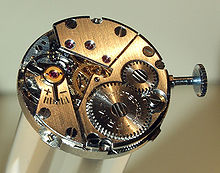Spring mechanism
A spring mechanism is a mechanical drive consisting of a spring and a gear with regulator or escapement . The spring is usually wound in a spiral shape and stores energy , which is then converted into a sustained rotary movement via a gear unit , if necessary.
In spring systems, one often strives for a particularly flat course of the torque characteristic . B. achieved by a decreasing cross-section of the tape from the inside to the outside or by a reversing winding direction in the elevator.
Demarcation
Also spring store mechanical energy brakes, the spring will, however, moves linearly and is not referred to as a spring mechanism.
Rubber motors are also not referred to as spring mechanisms, but are also used to store mechanical energy.
application
Spring mechanisms were and are used to drive mechanical clocks , short-term alarm clocks and time switches (e.g. exposure clock , microwave ). They are equipped with an escapement here .
Further application examples:
- Gramophones , music boxes , first tape recorders and rotary dials (telephones)
- meteorological measuring instruments , recorders
- Toys , in the drives of wind-up toys , e.g. B. in toy cars with Darda system , which causes the spring mechanism to be pulled up by moving the vehicle back
- mechanical cameras and film cameras
- Cable retractor, u. a. on vacuum cleaners (here without gear and escapement)
Spring mechanisms are often used when electric drives cannot be used due to the risk of explosion , high humidity or low temperatures. Coupled with a generator, they can also be used to generate electrical energy when batteries cannot be used or available.
history
Spring mechanisms were the first easily controllable, easily transportable and universally applicable drive. They were or are often equipped with devices for speed stabilization (e.g. climbing wheel , centrifugal governor or aerodynamic brake).
Before batteries and electric motors became available , the spring mechanism was the only way to implement a position-independent, mobile drive.
As a precision mechanical product, spring mechanisms are complex and therefore expensive to manufacture.
